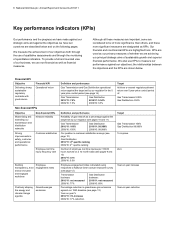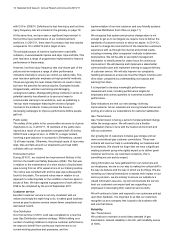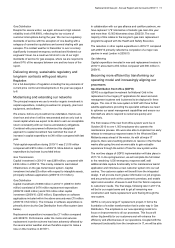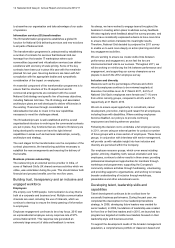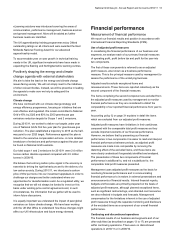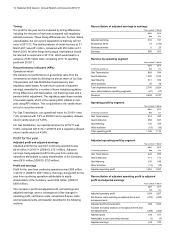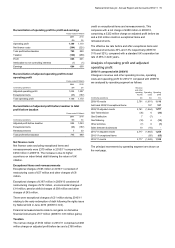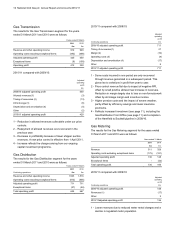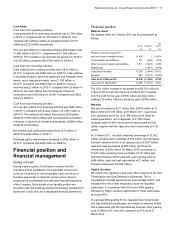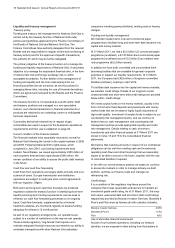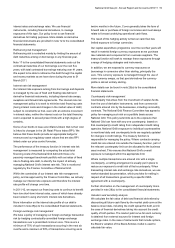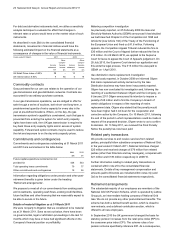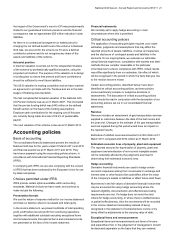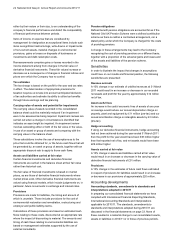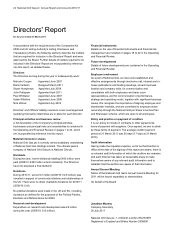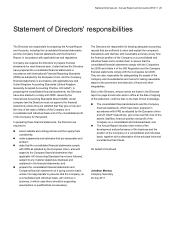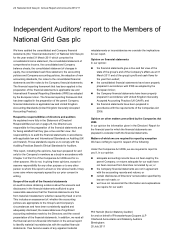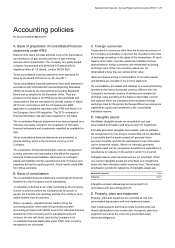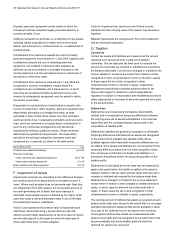National Grid 2011 Annual Report Download - page 20
Download and view the complete annual report
Please find page 20 of the 2011 National Grid annual report below. You can navigate through the pages in the report by either clicking on the pages listed below, or by using the keyword search tool below to find specific information within the annual report.
18 National Grid Gas plc Annual Report and Accounts 2010/11
Liquidity and treasury management
Treasury policy
Funding and treasury risk management for National Grid Gas is
carried out by the treasury function of National Grid under
policies and guidelines approved by the Finance Committees of
the Boards of National Grid and National Grid Gas. The
Finance Committees have authority delegated from the relevant
Boards and are responsible for regular review and monitoring of
treasury activity and for the approval of specific transactions,
the authority for which may be further delegated.
The primary objective of the treasury function is to manage the
funding and liquidity requirements of National Grid. A secondary
objective is to manage the associated financial risks, in the form
of interest rate risk and foreign exchange risk, to within
acceptable boundaries. Further details of the management of
funding and liquidity and the main risks arising from our
financing activities are set out below, as are the policies for
managing these risks, including the use of financial derivatives,
which are agreed and reviewed by the Boards and the Finance
Committees.
The treasury function is not operated as a profit centre. Debt
and treasury positions are managed in a non-speculative
manner, such that all transactions in financial instruments or
products are matched to an underlying current or anticipated
business requirement.
Commodity derivatives entered into in respect of gas
commodities are used in support of the business’s operational
requirements and their use is explained on page 20.
Current condition of the financial markets
The financial markets have essentially returned to normal for
National Grid following the turmoil in the capital markets in 2008
and 2009. Following National Grid’s rights issue, which
completed in June 2010, our funding requirements were
modest. Nevertheless, we issued approximately £350 million of
new long-term debt and also repurchased £368 million. We
remain confident of our ability to access the public debt markets
in the future.
Cash flow and cash flow forecasting
Cash flows from operations are largely stable annually and over
a period of years. Our gas transmission and distribution
operations are subject to multi-year price control agreements
with our regulator, Ofgem.
Both short and long-term cash flow forecasts are produced
regularly to assist the treasury function in identifying short-term
liquidity and long-term funding requirements, and we seek to
enhance our cash flow forecasting processes on an ongoing
basis. Cash flow forecasts, supplemented by a financial
headroom analysis, are monitored regularly to assess funding
adequacy for at least a 12 month period.
As part of our regulatory arrangements, our operations are
subject to a number of restrictions on the way we can operate.
These include regulatory ‘ring-fences’ that requires us to
maintain adequate financial resources and restricts our ability to
undertake transactions with other National Grid subsidiary
companies including paying dividends, lending cash or levying
charges.
Funding and liquidity management
We maintain medium-term note and commercial paper
programmes to facilitate long and short-term debt issuance into
capital and money markets.
At 31 March 2011, we had a $2.5 billion US commercial paper
programme (unutilised), a $1.25 billion Euro commercial paper
programme (unutilised) and a €10.0 billion Euro medium-term
note programme (€5.2 billion issued).
In addition we have both committed and uncommitted bank
borrowing facilities that are available for general corporate
purposes to support our liquidity requirements. At 31 March
2011, the Company had £425 million of long-term committed
facilities (undrawn), expiring in April 2014.
To facilitate debt issuance into the capital and money markets,
we maintain credit ratings. Details of our long-term senior
unsecured debt and short-term debt credit ratings are provided
below within ‘credit ratings’.
We invest surplus funds on the money markets, usually in the
form of short-term fixed deposits and placements with money
market funds that are invested in highly liquid instruments of
high credit quality. Investment of surplus funds is subject to our
counterparty risk management policy, and we continue to
believe that our cash management and counterparty risk
management policies provide appropriate liquidity and credit
risk management. Details relating to cash, short-term
investments and other financial assets at 31 March 2011 are
shown in notes 15 and 16 to the consolidated financial
statements.
We believe that maturing amounts in respect of our contractual
obligations can be met from existing cash and investments,
operating cash flows and other financings that we reasonably
expect to be able to secure in the future, together with the use
of committed facilities if required.
In line with our normal treasury practice we expect to continue
to access the markets in order to manage actively our debt
portfolio, optimise our finance costs and manage our
refinancing risk.
Credit ratings
It is a condition of the regulatory ring-fence around the
Company that it uses reasonable endeavours to maintain an
investment grade credit rating. As of 31 March 2011, the long-
term senior unsecured debt and short-term debt credit ratings
respectively provided by Moody’s Investor Services, Standard &
Poor’s and Fitch were as follows (all with outlooks of stable):
Moody’s Investor Services A3/P2
Standard & Poor’s A-/A2
Fitch A/F2
Use of derivative financial instruments
As part of our business operations, including our treasury
activities, we are exposed to risks arising from fluctuations in


